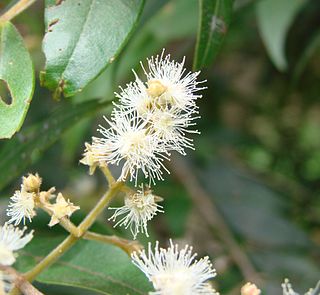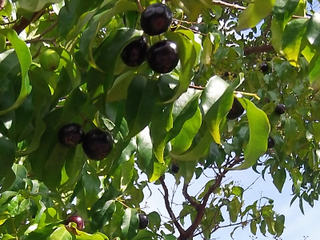
Psidium is a genus of trees and shrubs in the family Myrtaceae. It is native to warmer parts of the Western Hemisphere.

Eugenia is a genus of flowering plants in the myrtle family Myrtaceae. It has a worldwide, although highly uneven, distribution in tropical and subtropical regions. The bulk of the approximately 1,100 species occur in the New World tropics, especially in the northern Andes, the Caribbean, and the Atlantic Forest of eastern Brazil. Other centers of diversity include New Caledonia and Madagascar. Many of the species that occur in the Old World have received a new classification into the genus Syzygium.

Plinia cauliflora, the Brazilian grapetree, jaboticaba or jabuticaba, is a tree in the family Myrtaceae, native to the states of Rio de Janeiro, Minas Gerais, Goiás and São Paulo in Brazil. Related species in the genus Myrciaria, often referred to by the same common names, are native to Brazil, Argentina, Paraguay, Peru and Bolivia. The tree is known for its purplish-black, white-pulped fruits which grow directly on the trunk; they can be eaten raw or be used to make jellies, jams, juice or wine.

Myrcia is a genus of the flowering plant family Myrtaceae described as a genus with this name in 1827. As of 2015 it contains about 770 species. They are distributed in Central and South America, Mexico, and the West Indies.

Plinia is a genus of flowering plants in the myrtle family, Myrtaceae described by Linnaeus in 1753. It is native to Central and South America as well as the West Indies.

Blepharocalyx is a genus of plant in family Myrtaceae first described as a genus in 1854. It is native to South America and the West Indies.
- Blepharocalyx cruckshanksii(Hook. & Arn.) Nied. - Chile
- Blepharocalyx eggersii(Kiaerskou) L.R.Landrum - Lesser Antilles, Venezuela, Guyana, Peru, Brazil
- Blepharocalyx myriophyllus Mattos - Minas Gerais
- Blepharocalyx salicifolius(Kunth.) O.Berg - Brazil, Bolivia, Peru, Ecuador, Paraguay, Uruguay, N Argentina

Eugenia candolleana, or rainforest plum, is a tree native from Atlantic rainforest of Brazil, known locally by the Portuguese names cambuí roxo or murtinha. It is quite rare in the wild, and has seen limited use in landscaping for its bright green foliage and purple-black fruits.
Plinia oblongata, commonly known as jaboticaba azeda, is a species of plant in the family Myrtaceae. It is endemic to south-eastern Brazil. The tree grows to between 4 and 6 metres tall, and produces dark-purple, acidic but edible fruit, which is between 25 and 30mm in diameter.
Eugenia valsuganana is a species of plant in the family Myrtaceae. It is endemic to the municipality of Santa Teresa, Espírito Santo, Brazil and was first described in 2010. The tree grows to between 4 and 7 metres tall, and produces edible yellow fruit that are 16–20 mm in diameter.
Myrcia crassa is a species of plant in the family Myrtaceae. It is endemic to the municipality of Santa Teresa, Espírito Santo, Brazil, where its habitat is fragmented and declining due to deforestation. The tree was first described in 2010 and grows to between 1.5 and 18 metres tall.
Myrcia floridissima is a species of plant in the family Myrtaceae. It is endemic to the atlantic rainforest of eastern Minas Gerais, Brazil, where its habitat is fragmented and declining due to deforestation. The tree was first described in 2010 and grows up to 6 metres tall.
Myrcia mucugensis is a species of plant in the family Myrtaceae. It is endemic to Campos rupestres habitats in central Bahia, Brazil, 800 to 1000 metres above sea level. The shrub was first described in 2010 and grows to between 1.5 and 2 metres tall, with 2mm diameter fruits.
Myrcia pendula is a species of plant in the family Myrtaceae. It is endemic to rainforest habitats in south-east Bahia, Brazil, at 600 to 700 metres above sea level. The tree was first described in 2010 and grows to between 3 and 15 metres tall.
Myrcia pseudomarlierea is a species of plant in the family Myrtaceae. It is endemic to coastal rainforest habitats in southern Bahia, Brazil. The tree was first described in 2010, grows to between 4 and 20 metres tall, and produces red fruits between 12 and 15mm in diameter.
Myrcia pseudospectabilis is a species of plant in the family Myrtaceae. It is endemic to coastal rainforest habitats in southern Bahia, Brazil. The tree was first described in 2010, grows to between 1 and 6 metres tall, and produces purple or black fruits between 10 and 12mm in diameter.
Myrcia tetraphylla is a species of plant in the family Myrtaceae. It is endemic to coastal rainforest habitats in southern Bahia, Brazil. The tree was first described in 2010, grows to between 2 and 8 metres tall, and produces purple fruits between 15 and 22mm in diameter.
Plinia espinhacensis is a species of plant in the family Myrtaceae. It is endemic to the Espinhaço Mountains in the state of Minas Gerais, Brazil. The tree was first described in 2010 and grows up to 5 metres tall.
Marcos Eduardo Guerra Sobral is a Brazilian botanist. Since 2009 he has been an adjunct professor of Botany at the Federal University of São João del-Rei. As of the end of 2020, Sobral has authored 79 publications and published 237 taxon names, particularly within the Eugenia, Myrcia, and Plinia genera of the family Myrtaceae.
Myrciaria alagoana is a species of plant in the family Myrtaceae and is endemic to the state of Alagoas in the east of Brazil. Myrciaria alagoana was first described in 2012 and is related to Myrciaria glomerata.
Myrciaria evanida is a species of plant in the family Myrtaceae. It is endemic to Espírito Santo and Minas Gerais in Brazil. First described in 2013, it resembles Myrciaria floribunda.







